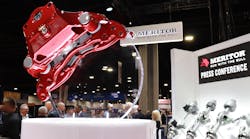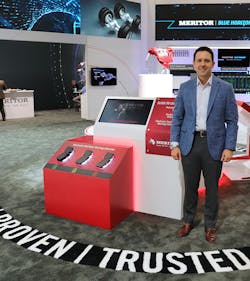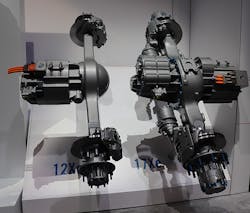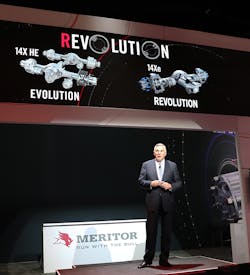ATLANTA — After 110 years serving the trucking industry, tracing its lineage industry to Timken Detroit Axle, Meritor is “still going strong,” noted CEO Jay Craig at the 2019 North American Commercial Vehicle Show.
“In fact, we’re building our momentum,” he added.
Appropriate as the company logo is a bull, but more so because the 2020s will be a decade of unprecedented innovation perhaps not seen since Timken axles supported the mechanical disruption of horse-drawn carriages way back when. The company needed to change, Craig argued, as he waxed on the themes of evolution and revolution, of continuous improvement and pioneering the next big thing in transportation: electrification.
The most significant revelation was that after nearly 20 years, Meritor has designed a brand-new brake from scratch, the EX+LS air disc brake. The single-piston brake weighs 71-lbs. (caliper and pads), the lightest Meritor has ever made, and is suitable for both for tractors and trailers performing long haul service in North America.
Air disc brakes don’t incur brake fade like drum brakes, and the single piston helps evenly distribute force onto the pusher plate. This provides better taper wear control than a twin-piston system, which can wear down unevenly.
In development since at least 2016, the EX+LS’ bona fides include 1 million miles of validation and more than 300 lab tests. More than 20 vehicles are currently using the system.
“By taking this purpose-built design approach we were able to optimize the performance, cost and weight of the product just for line haul,” said T.J. Reed, vice president of Front Drivetrain and Electrification for Meritor. He joined Meritor around the time the brake project was approved.
The predecessor, the twin-piston EX+L, which currently comes standard on the Class 8 Freightliner Cascadia and optional at all other major OEMs, weighs 74.5 lbs. Figuring for six brakes per 6x4 tractor, that is a 30-lb. improvement.
“When you're developing a brake, if you make it too light, it loses its stiffness, which impacts fatigue and other things,” Reed said. “So it's a pretty big technical feat to balance all that.”
Reed said the brake will be available first for trailers, and then for truck OEMs in 2021, and share some common parts, so fleet part inventories can be somewhat simplified.
The EX+LS air disc brake will come standard with the recently developed MA9300 N-level proprietary friction. This new material already complies with 2025 Environmental Protection Agency standards for reduced copper to decrease copper content in stormwater runoff and protect wildlife and plants. By 2021, brakes need to have less than 5% by weight and 0.5% by 2025. The N-friction material, which will also be available on the aftermarket and fits the EX+ L and EX+ H models, has 2.4 million miles of testing and has better pad wear and comparable rotor life to Meritor’s other offerings, such as the A-level MA761, with which it is interchangeable.
Additional options include padded shields and positive pad retraction to provide longer pad life and reduce brake drag. Sensors to detect rotor wear will also be available, which can help fleet managers sync up changes with scheduled maintenance intervals and reduce downtime, Reed said.
This system also allows for custom configurations combining drum and air disc brakes.
“We do see situations in the market where we can serve customers who want a disc brake on the steer axle and drum brake on the drive,” Reed said. “So that's something that's compelling to a fleet because you get a lot of the ride handling performance of an air disc brake on the steer axle, but the lower cost drum brake on the drive.”
The industry seems to be trending toward air disc brakes in general, said Reed, who previously spent two decades at DTNA developing products.
“If you go back even five years ago, air disc brake penetration in Class 8 was about 15%,” Reed said. “We see that today; it’s probably near 35%. I don't know if we'll get to the point where Europe is at 80% plus, but I think fleets are testing a lot of air brakes now and making that decision.”
Electric Dawn
The lightweight brakes also fit into Meritor’s overall evolution as an electric vehicle supplier, where a premium is put on weight due to it impacting range and battery size. At the show, Meritor also added to its Blue Horizon portfolio with the 12Xe powertrain for Class 4 through 7 applications and 17Xe powertrain for heavy-duty 4x2 and 6x2 trucks.
The 12Xe for medium-duty trucks and buses has optimized gearing and a smaller axle housing, and flexible options for motors, transmissions, gear ratios and more. The four power options include 130, 150, 180 and 200 kW of continuous power.
The 17Xe for heavy-duty trucks allows up to 44 tons on a single drive axle and has 420 kW, serving regional and long haul in Europe, as well as transit buses, refuse trucks and terminal tractors.
"Meritor's expanding range of next-generation technologies that include comprehensive solutions for standard axles, remote-mount configurations or fully electric powertrain systems furthers our goal of becoming the electric drivetrain supplier of choice." said John Bennett, VP and CTO for Meritor.
Bennett said Meritor currently has 22 active e-mobility programs, with 130 vehicles implementing their electric drivetrains.
Production for the powertrains should begin in 2021.
Meritor is also one of seven suppliers taking part in Volkswagen Caminhões e Ônibus’ (VWCO) e-consortium in Brazil, which will use Meritor's 12X drive axle. InBev plans to use 1,600 e-delivery trucks, which will swap out the 12X for the 12Xe when it becomes available. VWCO said the project is the largest of its kind. The trucks had a 120-mile range during testing.
With this considerable amount of momentum and product pivot, the one thing at Meritor that needs no improvement is the logo, which will still be apropos for many years to come, as the company charges forth and takes the e-revolution head on.
All this has CEO Craig feeling bullish, to say the least.
“We led the industry for the last 100 years and plan to continue that trend for the next 100,” he finished.







